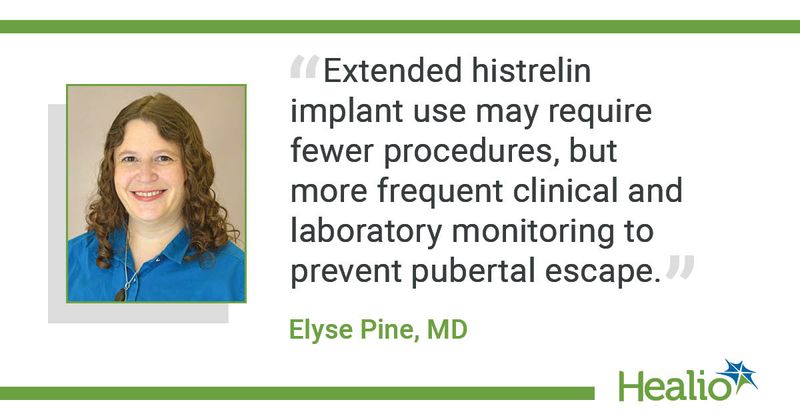Histrelin implants effective long term for transgender youths, central precocious puberty
Histrelin implants are effective in sustaining pubertal suppression for more than 1 year in most transgender adolescents and children with central precocious puberty, according to study results published in Transgender Health.

“The average use of a single histrelin implant in our study subjects was well beyond 1 year, at 37.5 months,” Maja Marinkovic, MD, associate clinical professor in the department of pediatric endocrinology at the University of California, San Diego, and medical co-director of the Center for Gender Affirming Care at Rady Children’s Hospital-San Diego, told Healio. “Pubertal suppression escape occurred in eight subjects at an average 30.4 months from placement: Five had only biochemical escape, two only clinical escape and one both clinical and biochemical escape. It is important to monitor patients who use a histrelin implant for an extended period both clinically and biochemically.”

Marinkovic and colleagues conducted a retrospective chart review of 49 youths with gender dysphoria or central precocious puberty who were seen at two U.S. pediatric centers and who used a histrelin implant for at least 17 months from 2010 to 2020. There were four groups included in the analysis: transgender and nonbinary youths treated with only a histrelin implant (n = 25); transgender and nonbinary youths treated with gender-affirming hormone therapy and a histrelin implant (n = 15); transgender and nonbinary youths who did not adhere to recommended testing and follow-up (n = 2); and youths with central precocious puberty (n = 7). Pubertal suppression was defined as estradiol of less than 20 pg/mL, testosterone less than 30 ng/dL or a lack of Tanner stage progression during a physical examination. Pubertal escape was defined as an increase in Tanner stage, estradiol increasing above 20 pg/mL or testosterone levels increasing above 30 ng/dL. All data were obtained through electronic medical records.
Histrelin implants effective for transgender youths
All 49 participants had pubertal suppression for at least 15 months after insertion of a histrelin implant. In the transgender and nonbinary group treated with a histrelin implant only, the mean time of effectiveness was 25.5 months. Compared with baseline, participants had decreases in luteinizing hormone (0.44 mIU/mL vs. 0.12 mIU/mL), estradiol for those assigned female at birth (17.6 pg/mL vs. 3.5 pg/mL), and testosterone for those assigned male at birth (36 ng/dL vs. 8 ng/dL) during follow-up 17 to 65 months after insertion. Implants were removed in nine of the 25 participants at an average of 40.3 months after placement.
In transgender and nonbinary adolescents treated with gender-affirming HT and a histrelin implant, HT was started 5 to 18 months after implant placement. Hormone concentrations remained low, for a mean of 26 months. Luteinizing hormone decreased for the cohort from 1.65 mIU/mL at baseline to 0.15 mIU/mL at follow-up. After HT began, the researchers noted it was difficult to determine whether pubertal suppression was due to the implant or HT. The implant was removed in five of 15 adolescents by the end of the study, and one person had their implant replaced.
Efficacy in central precocious puberty
Of those with central precocious puberty, treatment began at a mean age of 7.9 years. In the five female participants in the group, luteinizing hormone declined from 2.5 mIU/mL at baseline to 0.08 mIU/mL at follow-up and estradiol decreased from 45 pg/mL to 2 pg/mL. All participants had their implant removed after a mean of 27.5 months.
Of the study cohort, 16% experienced pubertal escape during the study, with escape occurring at an average of 30.4 months after histrelin implant insertion. Four of the participants who had pubertal escape were transgender and nonbinary adolescents treated with only a histrelin implant, and the other four were transgender and nonbinary youths treated with gender-affirming HT and a histrelin implant.
“Extended histrelin implant use may require fewer procedures, but more frequent clinical and laboratory monitoring to prevent pubertal escape,” Elyse Pine, MD, trans youth lead physician at The Center for LGBTQ Health Equity – Chase Brexton Health Care in Baltimore, told Healio. “Fewer procedures can be beneficial by translating into lower risk from general anesthesia, lower cost to the family for the histrelin implant and related procedures — which may be especially important to families with high copays or high deductibles — and a lower time requirement for insurance authorization and surgical time.”
Of 22 participants who had an implant removed, 19 had uneventful procedures. One implant was removed in two pieces at 45 months, one broke into several pieces at 62 months and one was a minor complication in which the removal was described as difficult due to encapsulation. There were no reports of excessive bleeding or infection.
Pine said more studies are needed to explore the mechanisms behind long-term histrelin implant efficacy.
“Prospective studies designed to explore the optimal timing for monitoring implant efficacy in order to avoid pubertal escape are necessary,” Pine said. “Prospective design and larger sample numbers would allow us also to examine whether there are patient characteristics that are associated with prolonged efficacy, such as diagnosis, age or BMI.”
For more information:
Maja Marinkovic, MD, can be reached at mmarinkovic@rchsd.org.
Elyse Pine, MD, can be reached at epine@chasebrexton.org.

